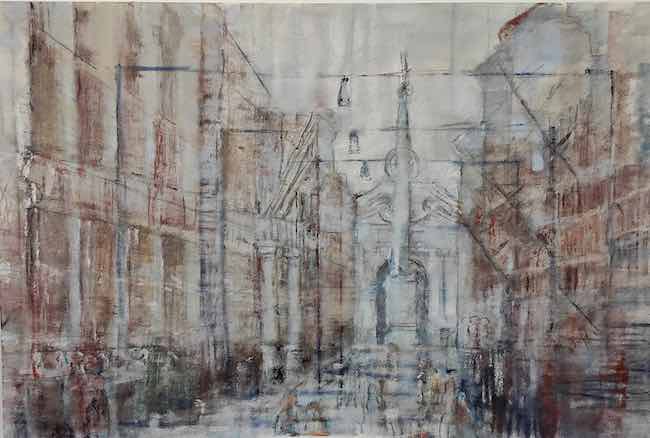Nell’arte contemporanea l’assoluta libertà creativa concede agli artisti di scegliere l’approccio più affine alle proprie caratteristiche e all’intenzione espressiva che costituisce la base del loro lavoro; alcuni tendono a restare fortemente attaccati alla figurazione, all’equilibrio estetico attraverso cui danno uno spaccato della società attuale lasciando trasparire, a volte persino inconsapevolmente, considerazioni e opinioni che toccano le corde dell’osservatore. Altri preferiscono invece affidare all’astrazione più totale l’interpretazione di un mondo interiore troppo indefinito per poter rientrare all’interno di confini formali che costituirebbero un limite al sentire e al comunicare; poi ci sono quelli che restano invece nel mezzo, tra astrazione e figurazione, dove l’intensità emozionale non può fare a meno di legarsi in qualche modo all’immagine conosciuta, sebbene filtrata dall’interiorità che ne ridefinisce i confini. L’artista di cui vi racconterò oggi dà vita a un suo linguaggio personale attraverso cui sottolinea l’importanza dell’ascolto dell’invisibile in grado di cambiare volto alla realtà osservata.
Quando gli artisti di fine Ottocento cominciarono a reclamare la necessità nell’espressione pittorica e scultorea di non trattenere più quei moti interiori, quella soggettività troppo a lungo esclusa dall’arte accademica del passato, vide la luce un movimento destinato a segnare la storia, a tracciare un solco importante nell’approccio alla tela in cui tutto ciò che doveva predominare era proprio l’emozione a lungo lasciata in silenzio ed esclusa dalla composizione di un’opera. Inizialmente questo principio fu affermato con forza, con l’irruenza tipica del bisogno di mettere in evidenza ciò che prima era stato in ombra, così l’Espressionismo, questo il nome della corrente artistica, assunse tinte forti, impetuose, irreali, e forme lontanissime da quelle regole tradizionali che avevano contraddistinto la pittura fino a qualche anno prima. Dalle tonalità piene e delimitate da evidenti contorni dei Fauves, lentamente il movimento si spostò verso un approccio figurativo differente sulla base del paese di provenienza degli artisti che vi aderirono, tanto quanto l’intenzione pittorica si adeguò alle caratteristiche del singolo autore dell’opera, rimanendo più aderente all’irrealtà, al sogno, a un mondo ideale come per Marc Chagall ed Henri Matisse, spostandosi verso il buio dell’anima, l’angoscia e l’inquietudine degli espressionisti del Nord Europa come Edvard Munch ed Emil Nolde, oppure rompendo ogni ponte con la morale dell’epoca come nel caso dell’austriaco Egon Schiele. Con il trascorrere del tempo e l’avanzare del Ventesimo secolo molti estremi cominciarono a sfumarsi, a stemperarsi anche in virtù della differente situazione geopolitica europea, permettendo gli artisti di orientarsi verso una rappresentazione più tranquilla, più attenta all’interiorità e alla psicologia ma soprattutto più libera di lasciarsi andare a contaminazioni e personalizzazioni che estinsero di fatto la necessità di appartenenza a un definito stile per entrare in un mondo più possibilista, più personalizzato e affine alle corde intuitive e comunicative del singolo esecutore di un’opera. Così come le emozioni cominciarono a non dover più essere solo gridate ma a volte anche sussurrate, in virtù di un punto di vista più contemplativo, empatico e aperto nei confronti delle energie circostanti; è esattamente questa la caratteristica che identifica Elisabetta Martinez, artista romana e figlia del maestro Luigi Martinez, la quale mescola e sovrappone tecniche differenti ma funzionali a esprimere il suo delicato punto di osservazione sulla realtà, attento a lasciar emergere tutto ciò che da un lato appartiene alla memoria, dall’altro alle voci silenziose che si legano all’immaginario, al percepito attraverso la spiritualità che non può fare a meno di fuoriuscire dalle sue tele.
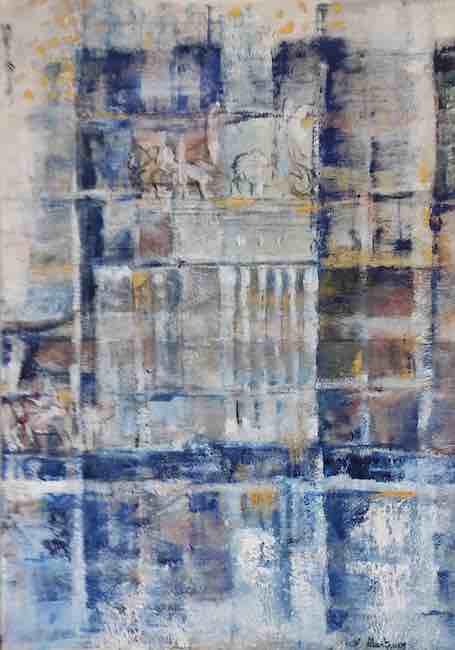
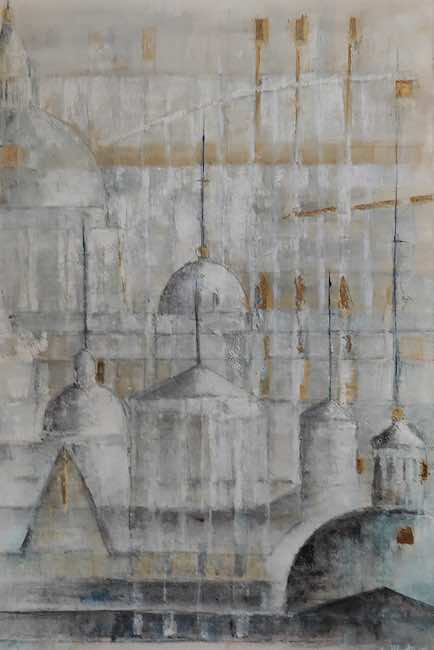
Il suo è un linguaggio pittorico personale, intimo, che da un lato si lega indiscutibilmente alla figurazione e anche all’approccio geometrico che le viene dalla sua professione di architetto, evidente nelle linee disegnate a carboncino con cui dà struttura alla base dell’opera, subito dopo però, attraverso l’utilizzo del colore a olio e della foglia oro, sovrappone alla schematicità una morbidezza espressiva fatta di velature le une sull’altra che infondono nell’osservatore la sensazione di trovarsi davanti a un sogno, un mondo in cui lasciar fluire l’immaginazione che emerge dall’impalpabilità delle immagini sussurrate dalla Martinez.
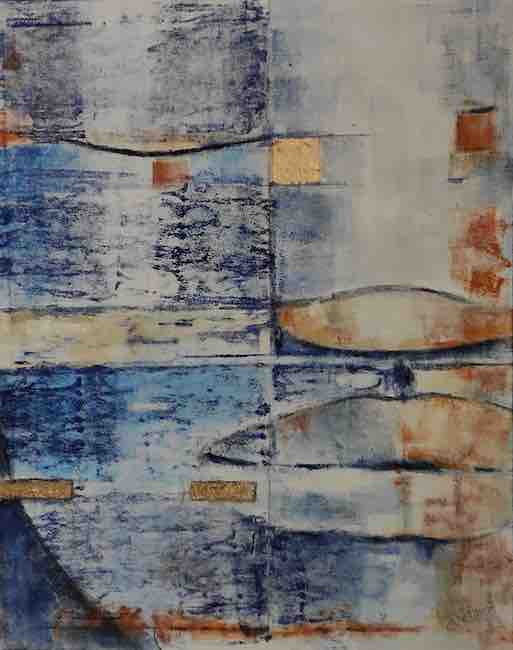
Si ispira a luoghi fortemente spirituali l’artista, i giganti di Nemrut Dagi in Turchia, i templi del Bayon in Cambogia, le sculture ciclopiche dell’arte egizia e alle icone del buddismo, a cui sovrappone la realtà osservata costantemente nella sua città, Roma, ma anche su volti femminili che appartengono a tutte e a nessuna, nascosti nei tratti riconoscibili perché l’esigenza è quella di lasciare che l’emotività si ponga in comunicazione con la spiritualità, quell’ascolto necessario ad andare oltre, a percepire le energie interiori più che l’apparenza estetica che tanto sembra essere predominante nella società contemporanea.
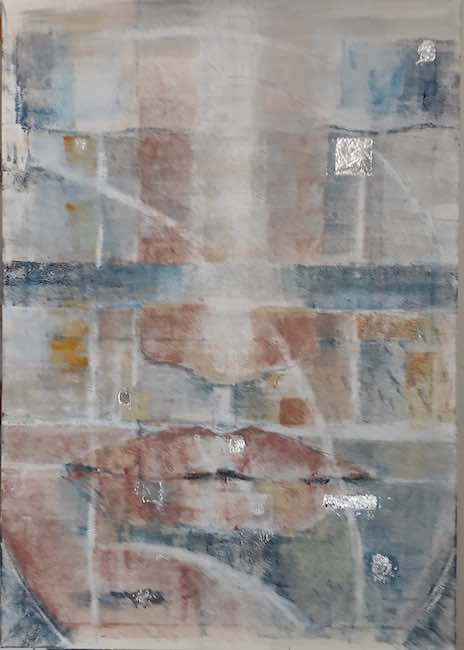
La magia della stratificazione, dei differenti livelli visivi, può essere riconducibile alle infinite possibilità, a quelle realtà quantiche che possono permettere all’individuo di scegliere di vedere ciò che la sua sensibilità gli consente, di trasformare ogni circostanza, ogni frammento, in un’opportunità di modificare ciò che lo sguardo coglie per spostarsi verso quanto l’animo chiede, di cui ha bisogno per elevarsi e procedere verso una direzione migliore, più affine al proprio vero sé.
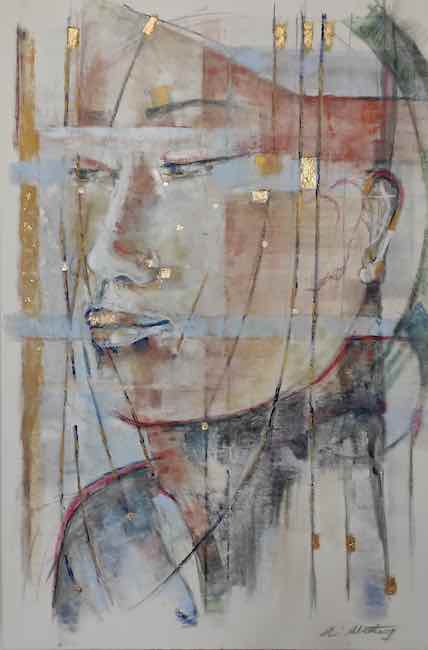
Questa è la sensazione che viene ricevuta guardando la tela Il viaggio del vento, silenzi di stelle in cui la donna stilizzata sembra attendere una risposta alla domanda che non ha il coraggio di fare, concentrata sul silenzio del soffio di quel vento che diviene metafora dell’attesa fiduciosa che prima o poi la risposta emergerà da sola attraverso un segno, una rivelazione che giungerà in virtù delle energie circostanti. La spiritualità orientale, evidenziata nel volto della protagonista, rappresenta un modo differente di porsi nei confronti dell’esistenza, più orientata all’individuo, ma priva di individualismo inteso nell’accezione negativa che abitualmente si attribuisce al termine, più attenta a un equilibrio che non può che generare benessere, all’individuo e a tutto ciò che lo circonda. È questa l’esortazione di Elisabetta Martinez, un bisbigliato invito ad apprendere quel modo di essere lontano dalla vita occidentale eppure incredibilmente benefico per l’anima e in grado di modificare il senso di tutte le credenze limitanti che spesso costituiscono un blocco evolutivo.
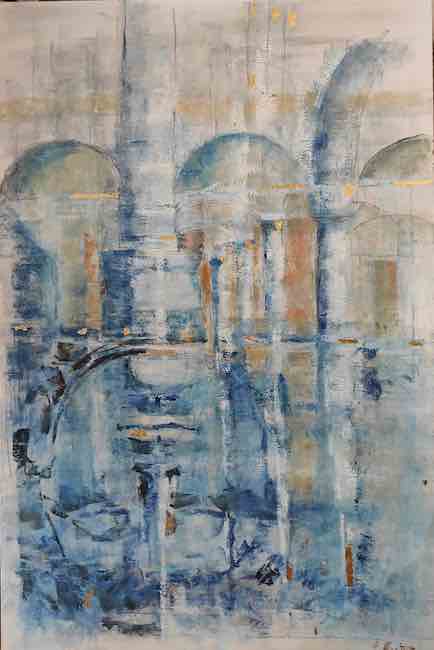
Nei paesaggi dell’artista emerge ancor più chiaramente la geometricità, l’attenzione alle forme derivante dalla sua formazione come architetto che però non compromette la possibilità di una successiva interazione della morbidezza che emerge in virtù della trasparenza, dell’impalpabilità delle immagini che inducono l’osservatore a riflettere sull’immortalità di scorci e paesaggi sopravvissuti alle civiltà alternatesi nel corso dei secoli, che sembrano essere sospesi tra il passato e il presente, tra il realismo della vita attuale e l’immaginazione silenziosa di tutto ciò che i monumenti e le vie hanno visto accadere e susseguirsi. La serie più recente è dedicata a Roma, la città in cui vive e di cui non può fare a meno di respirare la bellezza, l’atmosfera e la suggestione che le appartiene e che fuoriesce dagli scorci che la Martinez sceglie di rendere protagonisti, come se volesse indurre l’osservatore a guardare al di là dell’abitudine quotidiana a vedere distrattamente quei luoghi per soffermarsi invece a respirare il magico profumo di eternità che emerge solo nel momento in cui gli occhi si lasciano guidare dall’anima.
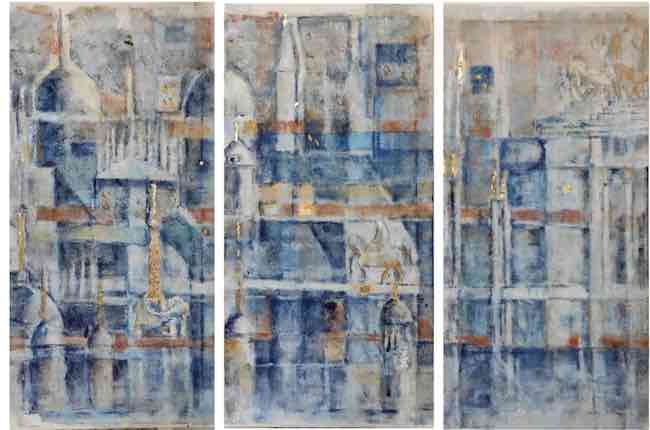
Nel trittico Viaggi sotto la luna, elefantini e destrieri sui tetti di Roma scompone e stratifica diversi punti di osservazione dando vita a un’ambientazione fantastica, quasi fiabesca, in cui il fascino della città sembra accresciuto, evidenziato dai dettagli in foglia oro, dalla predominante cromatica sui toni dell’azzurro e dei beige, e moltiplicato dalla ripetizione delle immagini in sequenza, come se Elisabetta Martinez volesse attingere alla tecnica cubista del mettere tutte le dimensioni sullo stesso piano visivo, quello bidimensionale, che tutto mostra pur affidando poi, nel suo caso, la capacità interpretativa all’intuizione, alla sensibilità interiore. Elisabetta Martinez, malgrado gli studi scientifici e tecnici di architettura, non si è mai allontanata dalla passione per la pittura che l’ha condotta a sperimentare varie tecniche fino a giungere al linguaggio attuale; ha all’attivo numerose mostre personali e collettive su tutto il territorio nazionale ed è artista ospite della storica Associazione Cento Pittori di via Margutta.
ELISABETTA MARTINEZ-CONTATTI
Email: cosmomartinez@libero.it
Facebook: https://www.facebook.com/elisabetta.martinez.7
Instagram: https://www.instagram.com/martinez_elisabetta/
The intangibility of spirituality in the places between memory and imagination by Elisabetta Martinez
In contemporary art, absolute creative freedom allows artists to choose the approach most akin to their own characteristics and the expressive intention that constitutes the basis of their work. Some tend to remain strongly attached to figuration, to the aesthetic balance through which they give a cross-section of present-day society, allowing considerations and opinions to transpire, sometimes even unconsciously, that touch the observer’s chords. Others, on the other hand, prefer to entrust to total abstraction the interpretation of an inner world too indefinite to fit within formal boundaries that would constitute a limit to feeling and communicating; then there are those who instead remain in the middle, between abstraction and figuration, where the emotional intensity cannot help but bind itself in some way to the known image, albeit filtered by the interiority that redefines its boundaries. The artist I am going to tell you about today gives life to her own personal language through which she emphasises the importance of listening to the invisible that can change the face of the reality observed.
When artists at the end of the 19th century began to claim the need in pictorial and sculptural expression to not hold back anymore those inner motions, that subjectivity too long excluded from the academic art of the past, a movement was born that was destined to mark history, to trace an important furrow in the approach to the canvas in which all that had to predominate was precisely the emotion long left silent and excluded from the composition of an artwork. Initially this principle was forcefully asserted, with the typical impetuosity of the need to highlight what had previously been in the shadows, so Expressionism, this was the name of the artistic current, took on strong, impetuous, unreal hues and forms far removed from the traditional rules that had characterised painting until a few years before. From the full tones and marked contours of the Fauves, the movement slowly shifted towards a different figurative approach based on the country of origin of the artists who adhered to it, as much as the pictorial intention adapted to the characteristics of the individual author of the artwork, remaining closer to unreality, to dreams, to an ideal world as in the case of Marc Chagall and Henri Matisse, moving towards the darkness of the soul, the anguish and restlessness of the Northern European expressionists such as Edvard Munch and Emil Nolde, or breaking all bridges with the morals of the time as in the case of the Austrian Egon Schiele. With the passing of time and the advance of the 20th century, many extremes began to fade, to dissolve, also due to the different geopolitical situation in Europe, allowing artists to move towards a more tranquil representation, more attentive to interiority and psychology, but above all freer to let themselves go to contamination and personalisation, which in fact extinguished the need to belong to a defined style to enter a more possibilist world, more personalised and akin to the intuitive and communicative chords of the individual executor of an artwork.
In the same way, emotions began to be no longer only shouted but sometimes even whispered, by virtue of a more contemplative, empathetic and open viewpoint towards the surrounding energies; this is exactly the characteristic that identifies Elisabetta Martinez, Roman artist and daughter of master Luigi Martinez, who mixes and superimposes different but functional techniques to express her delicate point of observation on reality, careful to let emerge everything that on the one hand belongs to memory, on the other to the silent voices that are linked to the imaginary, to the perceived through the spirituality that cannot help but come out of her canvases. Hers is a personal, intimate pictorial language, which on the one hand is unquestionably linked to figuration and also to the geometric approach that comes to her from her profession as an architect, evident in the lines drawn in charcoal with which she gives structure to the base of the painting, immediately afterwards however, through the use of oil colour and gold leaf, she superimposes on the schematic nature an expressive softness made up of veiling one on top of the other that instils in the observer the sensation of being in front of a dream, a world in which to let the imagination flow, emerging from the impalpability of the images whispered by Martinez. The artist is inspired by strongly spiritual places, the giants of Nemrut Dagi in Turkey, the temples of Bayon in Cambodia, the cyclopean sculptures of Egyptian art and the icons of Buddhism, to which he superimposes the reality constantly observed in his city, Rome, but also on female faces that belong to everyone and to no one, hidden in recognisable features because the need is to let emotionality communicate with spirituality, that listening necessary to go beyond, to perceive inner energies more than the aesthetic appearance that seems to be so predominant in contemporary society.
The magic of layering, of the different visual levels, can be traced back to the infinite possibilities, to those quantum realities that can allow the individual to choose to see what his sensitivity allows him, to transform every circumstance, every fragment, into an opportunity to change what the gaze grasps to move towards what the soul asks for, what it needs to elevate itself and move towards a better direction, more akin to its true self. This is the sensation received when looking at the canvas The journey of the wind, silences of stars, in which the stylised woman seems to be waiting for an answer to the question that she does not have the courage to ask, concentrated on the silence of the breath of that wind that becomes a metaphor for the confident expectation that sooner or later the answer will emerge on its own through a sign, a revelation that will come by virtue of the surrounding energies. The oriental spirituality, highlighted in the face of the protagonist, represents a different way of approaching existence, more oriented towards the individual, but devoid of individualism in the negative sense usually attributed to the term, more attentive to a balance that can only generate well-being, to the individual and to all that surrounds him. This is Elisabetta Martinez’s exhortation, a whispered invitation to learn that way of being far from western life and yet incredibly beneficial for the soul and capable of changing the meaning of all limiting beliefs that often constitute an evolutionary block. In the artist’s landscapes, emerges even more clearly the geometricity, the attention to form deriving from her training as an architect, which, however, does not compromise the possibility of a subsequent interaction of the softness that arises by virtue of the transparency, the impalpability of the images that induce the observer to reflect on the immortality of views and landscapes that have survived the alternating civilisations over the centuries, that seem to be suspended between the past and the present, between the realism of present life and the silent imagination of all that the monuments and streets have seen happen and follow one another.
The most recent series is dedicated to Rome, the city in which she lives and of which she cannot help but breathe in the beauty, atmosphere and suggestion that belongs to it and that goes out from the glimpses that Martinez chooses to make protagonists, as if she wanted to induce the observer to look beyond the daily habit of distractedly seeing those places to pause instead to breathe in the magical perfume of eternity that emerges only when the eyes let themselves be guided by the soul. In the triptych Travles under the moon, elephants and steeds on the roofs of Rome, she breaks down and layers different points of observation to create a fantastic, almost fairytale-like setting in which the city’s charm seems heightened, highlighted by the gold leaf details, by the predominant colours of light blue and beige, and multiplied by the repetition of the images in sequence, as if Elisabetta Martinez wanted to draw on the cubist technique of putting all dimensions on the same visual plane, the two-dimensional one, which shows everything while entrusting, in her case, the interpretative capacity to intuition, to inner sensitivity. Elisabetta Martinez, despite her scientific and technical studies in architecture, has never strayed far from her passion for painting, which has led her to experiment with various techniques until arriving at her current language. She has numerous solo and group exhibitions throughout Italy and is a guest artist at the historic Cento Pittori di via Margutta Association.


